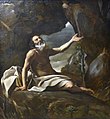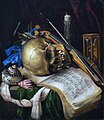Musée des Beaux-Arts (Marseille)
The Musée des Beaux-Arts (German: Museum of Fine Arts ) is the oldest museum in the city of Marseille . It is located in the Palais Longchamp in the 4th arrondissement . The collection includes European paintings, drawings and sculptures from the 16th to the 19th centuries. The focus of the collection is on works by artists from the Provence-Alpes-Côte d'Azur region .
history
The Musée des Beaux-Arts in Marseille was created in the course of the French Revolution on the initiative of the Interior Minister Jean-Antoine Chaptal . The Chaptal decree of 1801 established a total of 15 regional museums in France, which were supposed to house art treasures from former church property and from confiscated private collections. The Musée des Beaux-Arts in Marseille was founded in 1802, making it the oldest museum in the city. From 1804, the works of art were first exhibited in the chapel of the Benedictine monastery ( Couvent des Bernardines ) before a new museum building was available during the Second Empire . The Palais Longchamp, built in the historicism style from 1832–1869 according to plans by the architect Henri-Jacques Espérandieu, houses the Musée des Beaux-Arts in one wing, while the second wing houses the Muséum d'histoire naturelle (Natural History Museum). The facade design of the Musée des Beaux-Arts includes inscriptions by artists such as Michelangelo , Tizian , Raffael , Velázquez and Rubens . The Musée des Beaux-Arts was extensively renovated from 2005 and the interior redesigned. The reopening took place in 2013 as part of the alignment of Marseille as Capital of Culture (Marseille-Provence 2013).
collection
The first works of art came to Marseille from government grants as part of the founding of the museum. Later, other works of art followed by transfer of ownership by the French government, donations from citizens and purchases by the city of Marseille.
The collection of Italian baroque painting includes pictures with ancient subjects such as Cato of Utica says goodbye to his son by Giovanni Francesco Barbieri and biblical subjects such as Elijah is fed by the ravens by Giovanni Lanfranco , Saint Sebastian is cared for by Irene by Marcantonio Bassetti , Tobias heals the Eyes of his father by Gioacchino Assereto , dead Christ mourned by angels by Giuseppe Vermiglio , consecration of the Virgin by Lavinia Fontana and Christ and the adulteress by Giovanni Domenico Tiepolo . There are also secular works such as the portrait of a man by Bartolomeo Passarotti , a portrait of Cardinal Alderano Cibo by Carlo Maratta or the view The Gallery of Cardinal Valenti Gonzaga by Giovanni Paolo Pannini .
In the field of Flemish and Dutch painting, The Wild Boar Hunt by Peter Paul Rubens is one of the outstanding works in the collection. There are also a number of portraits, such as the portrait of Archduke Albrecht von Habsburg by Frans Pourbus the Younger , Portrait of a Man by Michiel Sweerts and two portraits by Jan van Bijlert . There is also a mysterious catch by Jacob Jordaens or a King David by Matthias Stomer
The collection of works by French artists is particularly extensive. Examples for the 17th century are religious motifs such as The Assumption of Mary Magdalene by Philippe de Champaigne , Mary Magdalene in Rapture by Louis Finson , Madonna with a Rose by Simon Vouet or the Presentation of the Virgin in the Temple by Eustache Le Sueur . There are also works such as the mythological subject The Judgment of Midas by Noël Coypel , the still life Vanitas by Simon Renard de Saint-André and landscape paintings by Francisque Millet and Nicolas Mignard . A separate room is dedicated to the painter and sculptor Pierre Puget , who was active in Marseille . Sculptures such as a faun and two portrait busts of King Louis XIV can be found here. His paintings in the collection include a Saint Cecilia and The Education of Achilles .
The painting of the 18th century is represented by works such as St. Roch asks the Virgin Mary to cure the plague sufferers by Jacques-Louis David , The Tempest by Claude Joseph Vernet , Portrait of Comte Saint-Florentin by Louis Tocqué , Marquise de la Tournelle as Dawn by Jean-Marc Nattier , The Duchess of Orleans by Élisabeth Vigée-Lebrun or the portrait of Giuseppe Fravega by Anne-Louis Girodet-Trioson . There are also works by Michel Serre and Françoise Duparc, who work in Marseille, or Michel-François Dandré-Bardon , who comes from Aix-en-Provence . Paintings from the 19th century include, for example, portrait of Madame Goldschmidt by Émile Auguste Carolus-Duran , Le Rêve by Charles Chaplin , portrait of a woman by Eva Gonzalès , portrait of Henri Didier by Thomas Couture , Le cuisinier comptable by Augustin Théodule Ribot , red stag in the water of Gustave Courbet , La Bouillie by Jean-François Millet , View of Riva by Jean-Baptiste Camille Corot , undergrowth by Narcisso Virgilio Díaz de la Peña , Les Graves à Vilerville by Charles-François Daubigny . There are also a number of works by Provencal artists such as Émile Loubon , Paul Guigou , José Silbert , Félix Ziem and Adolphe Monticelli from Marseille . The museum's significant sculptures include Le Ratapoil by Honoré Daumier and The Inner Voice by Auguste Rodin .
literature
- Christine Poullain: Chefs-d'oeuvre des musées de Marseille . Beaux arts magazine, Paris 2013, ISBN 979-10-204-0013-0 .
Web links
Individual evidence
- ↑ The spelling Musée des Beaux-Arts de Marseille is occasionally used to differentiate between art museums in other cities . However, the addition of de Marseille is not an official part of the museum's name. See, for example, the museum's website .
Coordinates: 43 ° 18 ′ 16 ″ N , 5 ° 23 ′ 38 ″ E





















